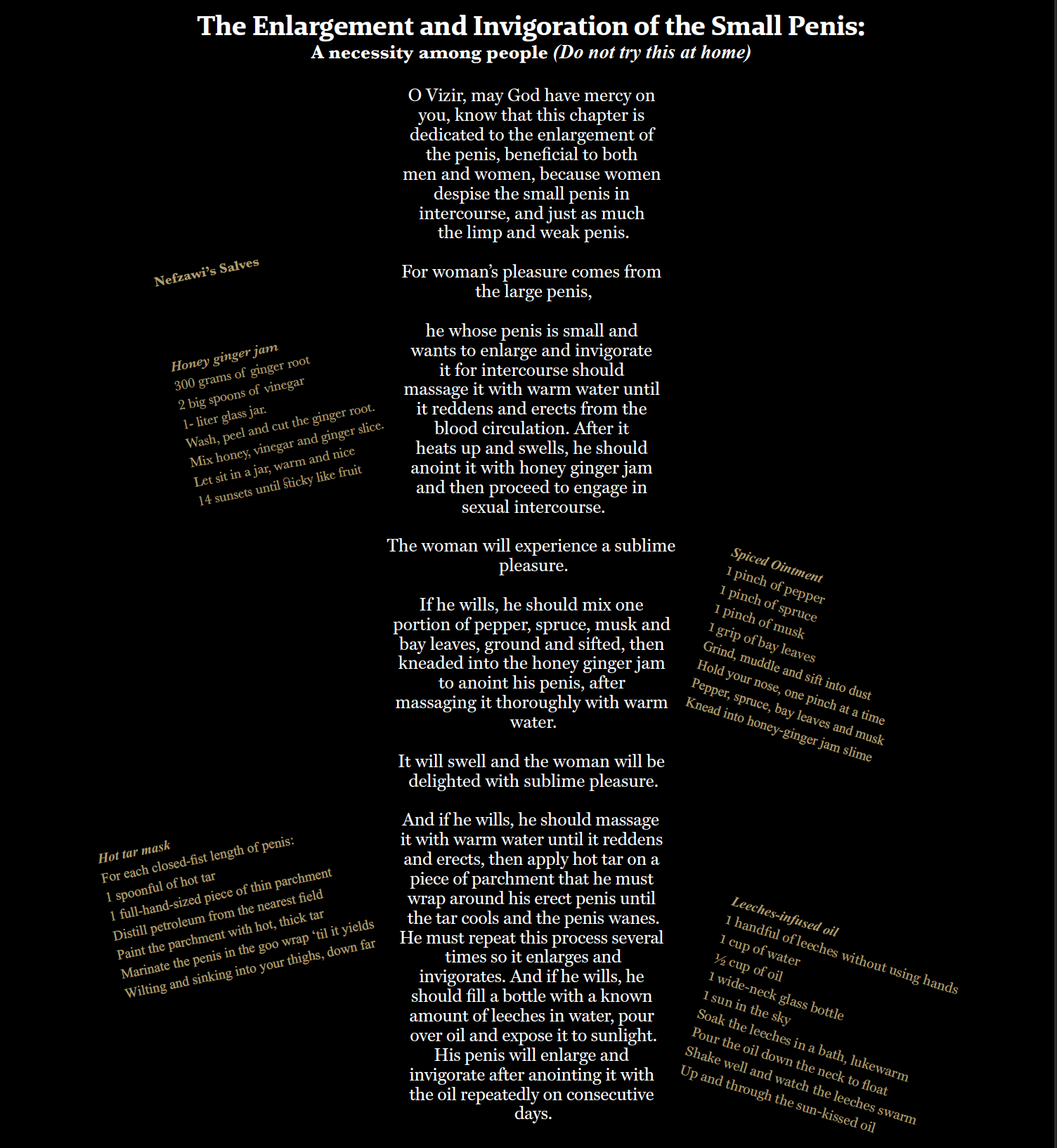Between 1420 and 1434, Sheikh Nefzawi, a writer from what is now considered south of Tunis, drafted a short sex manual entitled “Enlightened Performance in the Secrets of Coitus.” Upon the discovery of this work, the Chief Minister to Sultan Abdel Aziz Hafsi of Tunis, Muhammad ibn ‘Awaba Zawawi, comissioned Nefzawi to expand on the details of his manual, as he found it lacking of remedies and practical tips that people can apply to resolve any personal sexual issues. The manual was first translated to French in 1850 by a staff officer of the French army in Algeria, to then produce in 1876 an illustrated French autograph edition called Le Jardin Parfumé. Finally, in 1886, the French editor and translator Isidore Liseux, produced a revised edition of the original French translation. In the same year, Sir Richard Burton, a prominent English translator who was interested in translating texts like The Arabian Nights, translated Liseux’s translation from French to English to result in the first English translation of Nefzawi’s manual. Although this sex manual was not a pioneer in Arab erotological literature, it is worth exploring its sexosacral composite and the first English translation attempt. Among the limited number of available published erotological manuscripts is al-Jahiz’s Mufakharat al-Jawari wal-Ghilmān (Concubines and Youths in Competition), the oldest accessible treatise dating back to as early as the ninth century.
In this essay, I suggest approaching his translation as a “sanitization project” on the linguistic and stylistic levels that resulted in a bleaching of the sexosacral composite of the manual. Then, I will present my own transcreation of one of Nefzawi’s remedy chapters, where I learn from Burton’s liberties with the text but remain mindful of Nefzawi’s safeguarding of women’s pleasure. The sexosacral dynamic that I refer to does not assume the sexual to be in essence sacral and vice versa, as Tunisian sociologist Abdelwahad Bouhdiba[1]Bouhdiba, Abdelwahab. Sexuality in Islam. Taylor and Francis, 11. points out, but rather involves the social, as it is informed by both the exigencies of religious belief and the power of sexual desire. Unaware of this dichotomy, the sanitization project takes priority in cleaning language up from its specific sexual vocabulary and produces a pronounced language of censorship.
In the language of Lawrence Venuti[2]Venuti, Lawrence. The Translator's Invisibility: A History of Translation. Routledge, London;New York;, 2008;2012., Burton’s approach can be described as a domestication of the text to Victorian sensibilities. However, such a statement essentializes the translation process into the singular technique of domestication. His approach transposes the original to a completely different pitch, one that has its own reverberations and caters to ears habituated to certain musical, here literary, lexicon. In this procedure, Nefzawi’s voice is stripped off the skeleton of the instructive and illustrative manual, to give rise to the translator’s voice solely as an interpreter with ample autonomy, closely engaged in censorship as a main technique.
In addition to bleaching, Burton’s literary ménage depends on the addition of vague quotations and exoticization attempts. These are palpable in how he decorates the “dry'' instructive chapters with the heat of Orientalist description and spiced narration, particularly piquant for a Victorian reader. In a sense, he cleanses the overtly sexual, while paradoxically contaminating the text with other embellishments that heighten the fetishization of the Arab Muslim man and woman.
Take, for example, Nefzawi’s commitment to the usage of such concepts as ayr and farj as direct references to the genitalia of men and women, respectively. The translator’s camouflaging throughout falls short of conveying the sentiment of devotion that the author parades in his book to sex terminology and transparent description. By sanitizing the language on one hand, and amplifying the lustfulness through added stories and metaphors on the other, the translator contributes to an Orientalist project of making the erotic pornographic. There results an erasure of Nefzawi’s ideological stance, core to the sex manual: his consideration of an economy of pleasure existing in alignment with Muslim faith. The dominating language of censorship as a procedure in translation adopted by Burton brings to life the erotological piece of work as part of new discourses outside its Arabo-Muslim 15th-century context.
Nefzawi’s polemics reinscribe Muslim faith within an economy of love and desire. Departing from scripture, his work depletes the assumption of procreation as the elemental object of sexual activity. The spiritual practice of transcending the body is grounded in the creation and sustainability of corporal pleasure. He also exhibits the sociality of Muslim consciousness, one highly molded by oral tradition, notably hadiths. Going back to the original text, Burton’s approach to the manual narrows down the text to mere entertainment.
Bleaching Language: Censorship, Exoticization, and the Quest for Arab Pederasty
“In his ‘Terminal Essay,’ Burton theorizes a geo-erotic zone in which pederasty is endemic.”[3]Bristow, Joseph. The Homoerotics of Orientalism by Joseph Allen Boone (Twentieth Century Literature 64, no. 2, 2018), 25 As part of his deep interest in male pederasty, Richard Burton scrutinized Arabic texts for evidence on the practice. The drive to translate this manual was not so much centered on bringing to light the book’s relics in English, as to finding signs of homosexuality in Arab erotica that would prove his Orientalist assumptions, including heterosexuality as a coverup for same-sex desire, bestiality resulting from ignorance, and sexual repression from religiosity. His strategic pursuit of sodomical practice in a primarily heterosexual sex manual compromised the quality of the 1886 English translation, a clandestine production then made public through numerous reprintings. He contributes to the imperialist project concerned with defining the “nature” of Arabs, and validating sexual prejudices as ontological homoerotic desire. Burton goes as far to suggest that there is a missing 21st chapter about pederasty, claimed to have been left secret to conceal Arab shame, and treats it as a personal challenge to find the unadulterated version that would conclude his quest, in the writing of his improved translation The Scented Garden, burned by his wife to disable its publication. The “quest” and the shortcomings of the revised translation bring to light much of the imperialist sexual anxieties such as sexual crudity, ambiguous and uncontrollable desires, rather than they do unearth the essentialist tropes attributed to Arabs. In the “race” hierarchy created by this intention, Burton, in a way, takes on the doctor’s role in diagnosing Arabs with the disease of pederasty, an endemic ill that must be cured.
Surely, being aware of the scandalous history of this translation allows for a more relativist approach to Burton’s task as a translator. Had he not rounded the corners and bleached the language, perhaps the first manuscript would not have survived, published and circulated in 19th century England. Even if the second draft did, it would have possibly been more evident and exemplary of the usage of censorship to conceal any digressions from the Victorian perception of sexuality, consequently bringing out the unnuanced view of the erotic and pornographic.
Not only does Burton employ a language of censorship, he even goes further to quote well-known precepts to fulfill his motivations. In Chapter 4 on “Relating to the Act of Generation,” based on a “profound connoisseur in love affairs,” he compares women to fruit that must be handled in specific ways to emit aromatic scents. These additions, especially the focus on perfume as a feature of the seductive woman, feeds into the Orientalist view of Arab women, as well as contributes to their commodification. Since none of these phrases and ideas take part of the original text, Burton outdoes his job as a translator, to become a decorator of language, embellishing and accentuating the spicy topic of intercourse with added pungence. The translator’s intention to provide a manual that complies with his prejudicial image of the Arab “race,” as he calls it in his essay, seeps through passages that are fully scripted into the manual to expand its potential of exoticism, and thereby highlight the “Arab man” as a monolithic lustful entity.
Readapting Remedies
Burton’s exoticization attempt is discernible even beyond the manipulation of language, both in the decoratory and reductory sense. From the cluster of chapters on remedies at the end of the book, he makes a territory for readaptation where he rectifies certain practices. For example, Nefzawi includes a chapter concerned with dropping “the fetus from the womb.” In Burton’s version, the matching chapter is placed as the fourteenth, and opposite to the original, takes sterility as the primary problem that must be cured, without dealing with the topic of miscarriage or abortion altogether. His chapter is very similar in structure and content to that of Nefzawi’s on provoking miscarriage. A main point of discernment is the ending that leaves it to the will of God for the sterile woman to become pregnant. Yet, Nefzawi explicitly states in his chapter that the insertion of the bitters into the vagina “would kill the fetus and would leave him dead by God’s will.”
In Chapter 17, a less drastic adaptation, Burton effaces the agency of women and the centrality of their pleasure to this manual, evident in the original. He entitles this chapter “Prescriptions for Increasing the Dimensions of Small Members and for Making them Splendid,” a translation of the Arabic’s much more forthright approach to the gravity of enlarging the penis among most people. In his two-page translation of the single-paragraph Arabic chapter, he makes sure to include the pleasurability of this enlargement for men, one that is absent from the Arabic text: “Know, O Vizir (God be good to you!), that this chapter, which treats of the size of the virile member, is of the first importance both for men and women. For the men because from a good-sized and vigorous member there springs the affection and love of women.”[4]Burton, Sir Richard. The Perfumed Garden. Auckland: The Floating Press, 143.
Sheikh Nefzawi, in his work, mentions its beneficiality for both genders, yet only elaborates on the importance of the acclaimed procedure to women in intercourse, without giving the direct perspective of a man. Through his style and choice of phrasing, the woman is always the subject, wherein the remedy revolves around ensuring that her pleasures are fulfilled, especially evident through the repetition of the phrase: "فإن المرأة تتلذذ بـه لـذة عظيمة "[5]The woman will experience a sublime pleasure.. The translator then sets the woman in the object placement of most sentences, reducing her agency over her pleasure. For instance, when defining why “a good-sized and vigorous member” is enjoyable for both genders, he writes that “for women, because it is by such members that their amorous passions are appeased and the greatest pleasure is procured for them”, pleasure being a service granted to woman via a male agent. Another modification Burton makes to the original is his reduction of female pleasure into their “whole happiness” that “consists in the use of robust strong members”, eliminating the nuance between pleasure and happiness, as well as essentializing female feelings of joy to one male organ outside the reach of their own bodies. Additionally, he spices the remedies with phrases that do not exist in the original, For example, he amplifies the pleasures “procured” for a woman by man, including: “such pleasure that she objects to him getting off her again” and “afford to the woman a marvelous feeling of voluptuousness.”[6]Burton, The Perfumed Garden, 143.
He further appropriates the text as a translator, surpassing his task to become an active writer of remedies, by adding an additional two remedies using “an ass’s member” and one with “roisin and wax, mixed with tubipore, asphodel and cobbler’s glue.”[7]Ibid. It is important to note that not only are these remedies added by the translator without any relevance to the original, but also that these additions are neither time nor culture-specific assumptions about possible remedies used in the 15th century like the use of tubipore, a mainly pacific and Indian-ocean coral, or “cobbler’s” glue, a European adhesive brand. He also ends the chapter with an evident presence in the text, mentioning the efficacy of all these remedies for he had personally tested them.
Nefzawi’s Salves
I have provided my translation of chapter 18, “The Enlargement and Invigoration of the Small Penis,” from the original Arabic text. The chapter is an opportunity to revisit the historical uses of spices and natural home remedies to gain physical and sexual benefits. It also captures the view of female pleasure through the early Arab erotological text as well as the literary rhythm employed in such a text committed to providing medical instructions.


Riwa Roukoz
Riwa Roukoz is a freelance writer and an English Literature student at AUB. She published her first poetry book and in 2017. She is the founder of Writers Beirut, a local community for aspiring, emerging and professional writers to connect, inspire and work in the city. In her writings, she explores Arab identity, queer existence, self-love and self-discovery through traveling. She is also interested in researching themes of gender and sexuality in contemporary Middle Eastern literature.
Footnotes:
| ↑1 | Bouhdiba, Abdelwahab. Sexuality in Islam. Taylor and Francis, 11. |
|---|---|
| ↑2 | Venuti, Lawrence. The Translator's Invisibility: A History of Translation. Routledge, London;New York;, 2008;2012. |
| ↑3 | Bristow, Joseph. The Homoerotics of Orientalism by Joseph Allen Boone (Twentieth Century Literature 64, no. 2, 2018), 25 |
| ↑4 | Burton, Sir Richard. The Perfumed Garden. Auckland: The Floating Press, 143. |
| ↑5 | The woman will experience a sublime pleasure. |
| ↑6 | Burton, The Perfumed Garden, 143. |
| ↑7 | Ibid. |





